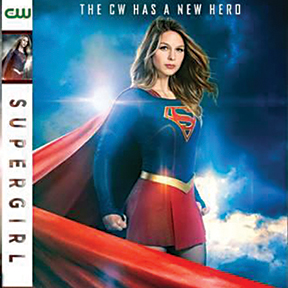
by Sierra Billingsley
Another super-heroine of note is longtime fan favorite Carol Danvers, Marvel’s eponymously named Ms. Marvel. Starting her career off as an officer in the US Air Force, Danvers later receives superhuman powers after her genes fuse with those of a Kree, a recurring alien race within the Marvel Universe. She quickly became a staple figure in-universe, often fighting alongside the Avengers and regularly appearing in the books of other popular characters. In our world, the nature of her character and progressive leanings of her book’s content had her closely related to the feminist moment of the 1970s.
In the 2010s, Danvers adopted a new nom-de-plume as “Captain Marvel,” taken from the previous Captain Marvel, with whom she had been closely associated prior to her own emergence as a superheroine, whose character had died in-universe. Her previous moniker was taken up by Kamala Khan, a Pakistani-American teen who is notable for being the first Muslim comic character to have a comic book run of her own.
DC is no stranger to intergenerational legacies either, with a prime example being Supergirl. Introduced in Action Comics #252 in 1959, the character has had many different incarnations, but the most enduring is that of Kara Zor-El. Teen cousin of the Man of Steel, Kara exists as the only other survivor of Krypton. Interestingly, she is actually older than her cousin chronologically, having been well into her teens when he was first born. However, upon being evacuated to Earth to escape the destruction of her home, Kara’s ship was knocked off course and didn’t arrive on Earth until many years after initially planned.
Being held in suspended animation for the duration of her trip, by the time she arrived on Earth her cousin was already fully grown, while she hadn’t aged a day. Left extremely disoriented, struggling to understand that decades had passed in what seemed like days to her and grappling with the fact that the only home she’d known was gone, the core of the Supergirl mythos is found in the story of a displaced young woman, by all standards a refugee, struggling to find new identity and purpose in an alien world.
The story is a compelling and enduring one, re-told time and time again since Supergirl’s initial appearance. The latest adaptation can be found on television in the form of the CW’s Supergirl, with Kara arriving on Earth when she was 13 before being adopted by a human family. Here, she spends the latter half of her adolescence hiding her Kryptonian nature before extraordinary circumstances push her into rediscovering that nature at the start of adulthood. However, Kryptonians don’t have a monopoly on legacies by any means. Some of the most notable examples of shared mantels come from the famously human superheroines Batgirl and Batwoman.
The first Batgirl was originally introduced as Betty Kane in 1961 before being renamed Barbara Gordon in 1967. Barbara Gordon, the daughter of the Gotham City police commissioner, like many female character initial inceptions, was simply to act as a female version of Robin. Unfortunately, through the 60s and 70s, her character didn’t receive much development beyond that of spunky sidekick and was even retired for a short period by DC in early 1988. However, the character was suddenly thrust back into the limelight later that year when she suffered a radical and controversial twist of fate in the story The Killing Joke, where she was shot and paralyzed from the waist down by the Joker.
Now confined to a wheelchair, Barbara Gordon underwent a deep transformation. From “spunky sidekick” to “young woman violently and senselessly paralyzed in the prime of her life,” Barbara was forced to look deep inside of herself and overcome both emotional and physical damage, lending to her character acquiring a depth never achieved before. The process had her build herself back up as a completely new type of crime fighter as she was reborn as Oracle. Tech wizard and information broker to heroes around the globe, Oracle’s fighting was done behind the scenes via keyboard. Becoming an essential asset to heroes around the world, Oracle would go on to head her own, all-female team, the Birds of Prey. The team, even with a fluctuating roster of characters, has remained one of the best series for exploring the group dynamic and growth amongst DC’s female characters.
Although Barbara would eventually be restored to the role of Batgirl in 2011, with the full restoration of her mobility, the trials she faced forged her into an undeniably unique and independent character and facilitated the birth of two notable young superheroines who both temporarily carried the Batgirl title – Cassandra Cain and Stephanie Brown. Currently known as Orphan and Spoiler, they’ve integrated themselves as popular members of Gotham’s well-loved Bat-Family.
Additionally, there is Batwoman. A title originally owned by Katherine “Kathy” Kane, whose debuted appearance was in Detective Comics #233 in 1956. Devised as a romantic counterpart to Batman, she was deployed to varying levels within Bat -related comics for several years before eventually being killed off in the 1970s. However, in 2010, the moniker of Batwoman was picked up by a different Katherine Kane, this one a direct descendent of the original Batwoman, going by “Kate.”
-related comics for several years before eventually being killed off in the 1970s. However, in 2010, the moniker of Batwoman was picked up by a different Katherine Kane, this one a direct descendent of the original Batwoman, going by “Kate.”
Kate Kane lost her mother and twin sister at a young age after a shootout between gunmen who’d taken the two hostage, and her father, a military man died in an attempt to save his wife and daughter. Later in life, Kate attends the US Military Academy in an effort to join the army, but she is ultimately expelled when it’s revealed she is in a intimate relationship with another woman, marking her one of the few notable lesbian superheroines in comics.
After being expelled, Kate was lost in life and struggled to orient herself. One night she is mugged. Due to her military training, she is able to fend off her attacker and, after finding inspiration in the actions and symbol of the Caped Crusader, decided to adopt the mantel of Batwoman for herself. With it, she finds a sense of purpose in crime fighting, and like many before her, fully surrenders to the life of a heroine.
From 1940 to 2017, from corner newsstands to the red carpets of Hollywood, women have been a staple of comics since the beginning, both among characters and among readers. One could say that a large factor in the success of Wonder Woman’s recent film, equally adored by female and male fans alike, was that it was built on the legacy of many beloved superheroines. Characters who often had to fight for screen time, whose writers had to prove their potential relevance and depth against skeptics, who were saved from obscurity time and time again. Without the evolution that so many of those heroines undertook to survive on their own pages, even the Amazon Princess herself would not have been able to cross that last hurdle onto the silver screen.
There are many ways to trace the history and progress of women characters in comic books, including visiting local shops like The Great Escape that carry both new comics featuring the exploits of these adventurers and back issue comics and trade paperbacks that both document and reprint their adventures from the past.
